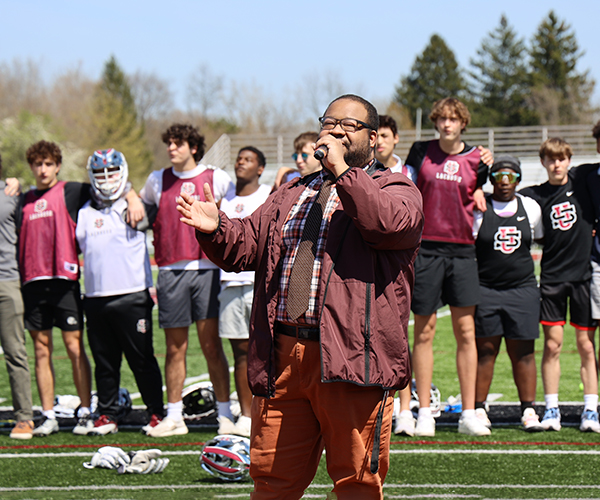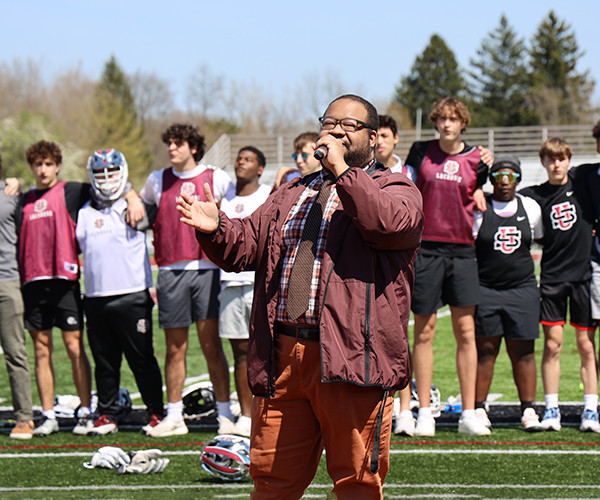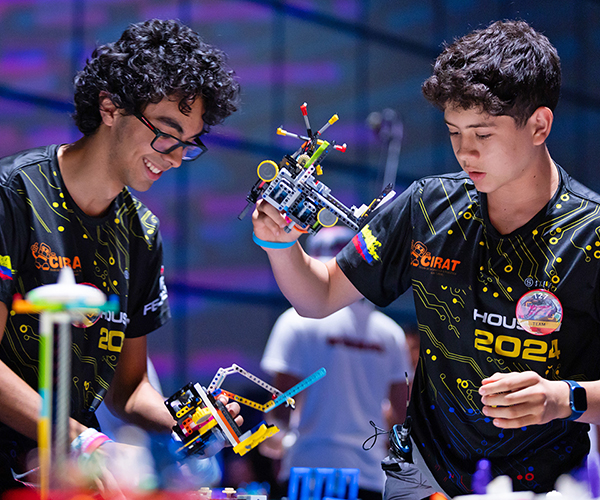Madeleine Barr arrived in Turkey on a school trip in June. But the students she met from other schools seemed like old friends.
That's because Barr and five other Hathaway Brown juniors and seniors had been communicating once a week via Skype with students from Virginia, North Carolina, California and Turkey for most of the last school year.
Every Wednesday at 7:30 a.m., the Hathaway Brown teenagers gathered in Joe Vogel's classroom and discussed that week's reading on Turkish culture, history and politics during a video conference with other schools. The students even started a Facebook group called Turkey Trip 2011 to keep in touch outside the classroom.
Vogel, who heads the Global Scholars Program, would project feeds from the other schools — including Roberts College, an exclusive private high school in Istanbul — on a large screen so the girls could see the other participants.
"We had some pretty good discussions," Barr says. "I don't think that we would have been able to all get as close and as comfortable as we were on the trip if we hadn't had all these discussions before and if we hadn't gotten familiar with each other's faces and known each other before we went on the trip."
According to many educators, that potential to expand learning beyond the classroom is among the reasons Northeast Ohio schools are experimenting with new technology in every level of education.
Laptop and tablet computers, video conferencing, social networks and computer simulations are just some of the innovations shifting the classroom from one that was exclusively guided by a teacher to one that encourages collaboration and requires students to learn how to find information, evaluate and manage it.
"In many ways, technology opens the doors to the classroom," says Barry Kallmeyer, director of Hathaway Brown's Worldwide Communication Center and coordinator of middle school information systems.
"Traditionally, as a teacher, you go in the classroom, the door closes, you are in your own realm. But when you bring in these devices, it opens the world to the students," he says. "We're in a world now where there is the ability to collaborate and create content to share with a worldwide audience."
Jim Harmon, a Euclid High School English teacher and graduate school instructor at Baldwin-Wallace College in Berea, calls technology — and particularly the iPad — the "game changer" of education.
Harmon, who is also an Apple Distinguished Educator, studied the use of iPads in his three sophomore and two freshman English classes at Euclid High School and presented his findings in June at the International Society for Technology in Education conference in Philadelphia. He compared his classes with that of two other sophomore English teachers classrooms (who taught three classes each), who did not use the iPad. All three teachers use the same exact curriculum.
Harmon's students, who used iPads for vocabulary acquisition apps, writing journal entries and playing word games, consistently performed better on the Ohio Graduation Test in both reading and writing.
The iPad's tablet format and computing capabilities even made reading for class more enjoyable.
"We were engaged more, and it gave us a better understanding of the words," says 16-year-old Brandy Somerville, a student in Harmon's class. "If there was a word you didn't understand, you could click on it, and it would take you to a dictionary to tell you what the word means."
The iPad's impact was even more impressive in the class's overall writing scores: 92 percent of Harmon's students passed the writing portion of the exam, whereas less than 85 percent of the students in the six other classrooms passed the test.
Those results surprised Harmon.
While many teachers are using iPads for content consumption, like reading, far fewer are using them for creation, like writing. Harmon had the students write journal entries on the iPad in class.
"My students wrote more," he says. "The quality of their writing was higher, and they were writing quicker than pencil and paper."
Others are jumping on the tablet bandwagon as well.
HB will implement school-owned iPads in early childhood classes through fifth grade in the fall. Beginning January 2012, seventh-graders will purchase their own iPad. Within two years, the tablets will be used throughout sixth, seventh and eighth grades, Kallmeyer says.
North Royalton schools will start using iPads for math in some middle school classrooms in the fall to see if it helps children with learning differences better understand math.
Susan Finelli, the district's curriculum facilitator and an instructor at Baldwin-Wallace College, sent teachers to Harmon's district to see the iPads in use and their potential for student-driven learning.
"They're learning at their own speed, in their own way, in their own time, because many programs adjust to the students' skill level," Finelli says. "The best learning is discovery, so when you put a tool like that in a student's hands where they're manipulating things and coming up with solutions on their own, to me, that is the greatest kind of learning that can happen."
That thinking has been a driver for technology adoption at Lawrence School's Upper School in Sagamore Hills as well.
An independent school for students with learning differences and attention difficulties, Lawrence School provides every seventh- and eighth-grade student a computer loaded with software tools that can be used to help overcome their individual learning challenge.
For example, ADHD students have programs that track reading to help students stay focused or can read the material to them for better understanding. In math, there is a program with a talking calculator. And, for writing, students can use a program that checks for the correct verb tense.
"It really levels the playing field for kids who are really interested in science, but have difficulty reading," says Sally Garza, Lawrence School's upper school technology director. "This takes the reading part out of the equation so they can still have discussions in class and know the concepts that are going on without actually getting bogged down with the struggles of decoding the phonics of reading."
Critics of so much technology entering the classroom say that it can be used as a babysitter and can get teachers off the hook from interacting with students. But Sue Shick, an instructional designer at Case Western Reserve University, believes in the potential of teachers to do more with the technology.
"I think most teachers want to use it in more creative ways," she says.
Consider how Gilmour Academy in Gates Mills integrates technology into classroom assignments, such as creating digital documentaries or playing simulation games.
Gilmour's freshman history classes, for example, incorporate computer games such as Civilization into their lessons. Students choose their own nation and interact with ancient civilizations while leading their country.
The strategy game teaches about cultures and geography at the same time, says Cathleen White, Gilmour's director of information and media services.
Similarly, The Intergenerational School, a Cleveland charter school, has been using the Second Life virtual game in an after-school program for grade school students.
The school may be the only one nationally using Second Life with students so young, according to Shick, who works with The Intergenerational School program.
Entry into a Second Life virtual world is usually limited to adults, but through a partnership with CWRU, The Intergenerational School students can come into a secure place behind a firewall where the young students create their own avatars and build their own virtual worlds.
Students' Second Life characters interact on an island they've created by forming the land, lakes, plants, homes and vehicles. They practice how to communicate and interact in the virtual world and sometimes even learn some computer programming in the process.
This coming year, students will work on creating a virtual garden that mirrors an actual garden at the school. One advantage of a virtual world, Shick says, is that they can experiment with ecological systems without hurting real plants.
"If you take away the sun for so many days, what's going to happen to the plants that are in your garden?" Shick asks. "If you can teach them about those kinds of dynamics, and they can model it and see it for themselves, that's unbelievably powerful."
Given the creative ways technology is being worked into area classrooms, it's easy to overlook some basic changes to day-to-day school life.
Euclid's Harmon, for example, no longer has to lug home boxes of spiral-bound journals. Instead, his students use a web-based education program called Moodle that allows Harmon to access their documents from anywhere.
Collaborative technology is becoming increasingly popular in area schools.
Hathaway Brown, for example, began using Google Docs online document spreadsheet and presentation platform last year, and the feedback has been positive, says Kallmeyer.
"It has allowed students and teachers to work collaboratively on documents or presentations, whether they're in the building or at home," Kallmeyer says. "There's no lost flash drives or emailing back and forth wondering what's the most up-to-date version."
Lawrence School uses a social networking site known as Saywire that allows students and teachers to interact online. Groups such as student council can create their own pages, and every student can access its calendar.
Because Lawrence students come from nine different Northeast Ohio counties, they are often too far apart to get together socially, says Lawrence School's Garza. It also allows the school to teach valuable lessons in what she calls "digital citizenship," understanding the proper use of
webcams, privacy laws and ethics.
"Students are digital learners," says North Royalton's Finelli. "Their brains are wired to react to these types of things, so if they're in a classroom with paper, pencil and a lecture, we're going to lose them. Our kids have changed, and therefore, our teaching methods need to change."
While technology trends are emerging, Euclid High School's Harmon says one of the most unexpected findings of his studies suggests that schools need to integrate more technology into the classroom.
Harmon asked students what motivated them to attend English class. Fewer than 5 percent of his students were spurred by technology, but almost 64 percent said, "Thinking about my future." Fewer than 32 percent of students in non-iPad classrooms said that.
"I was stunned," Harmon says. "My students looked right through the iPad. It was a tool. It was ubiquitous. They didn't think about it, and yet it really gave them the opportunity to really think about their future.
"I'm absolutely thrilled because we want them to think about the future," he says. "We want them to think about success and where they might end up."
The same might be said for technology in the classroom. "I don't think we've even scratched the surface yet," Harmon says.



